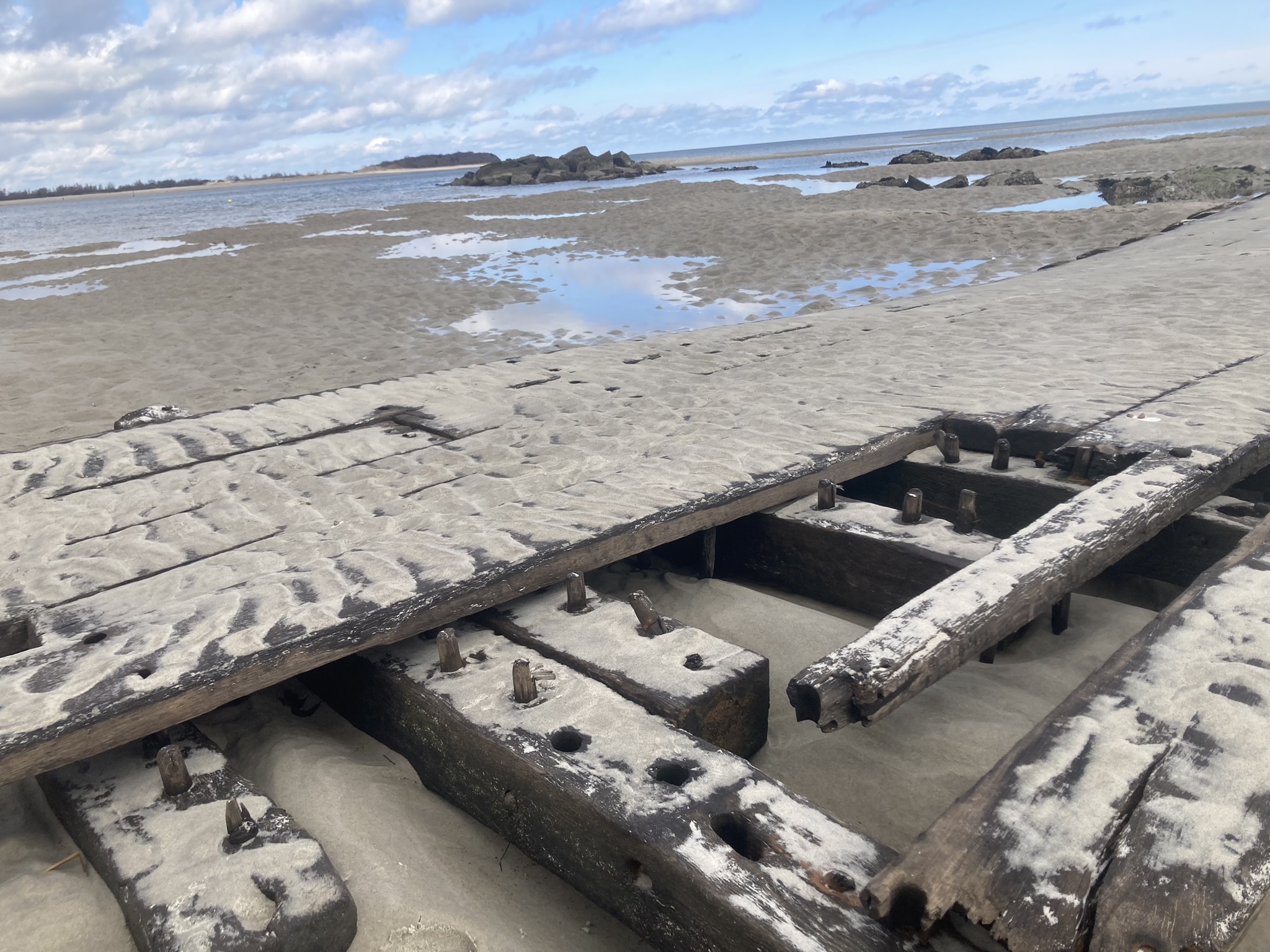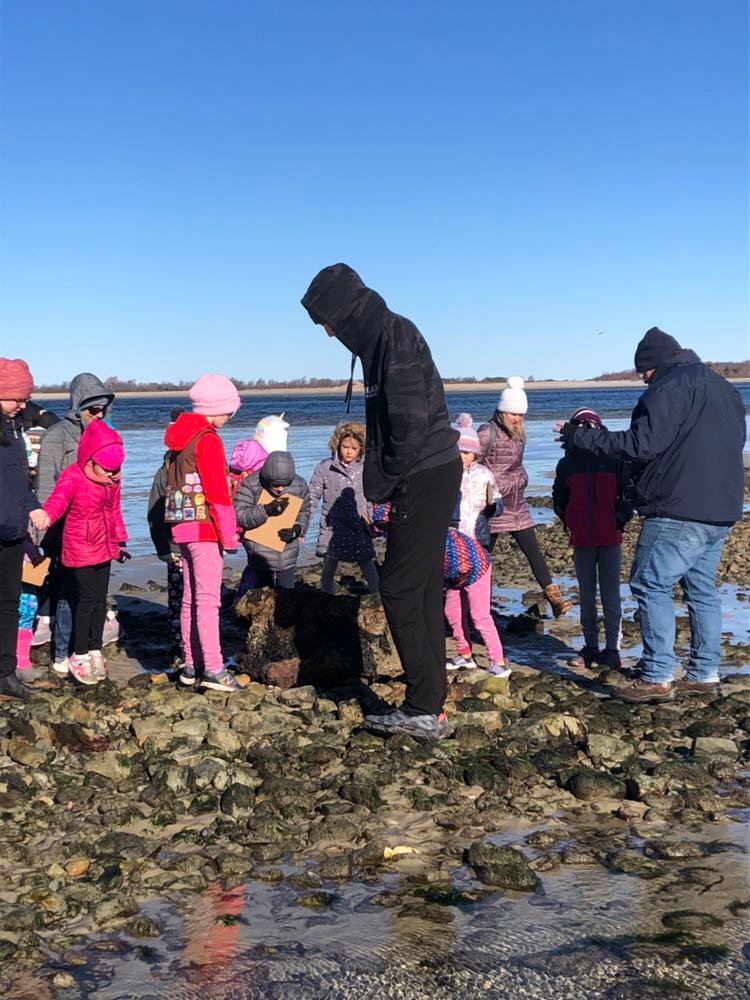
Recently uncovered portion of Ada K. Damon is submerged by waters at Crane Beach
In late February 2024, the sands of Steep Hill Beach on the Crane Estate in Ipswich shifted, and a roughly fifty-foot section of the hull of schooner Ada K. Damon emerged once again. Broken up by a combination of Hurricane Teddy and autumnal king tides in 2020, large sections of the previously intact lower portion of the ship’s hull had not been visible for several years. As an active archaeological site, this uncovered piece of the wreck offers a unique opportunity for knowledge building and community science.
History of Ada K. Damon
The schooner Ada K. Damon‘s presence on Steep Hill Beach has been well-documented for decades. Trustees’ archival photographs show children playing on and around the shipwreck as early as 1911 during the first annual Crane Beach Picnic. Ada K. Damon was a double-masted fishing schooner, built by Ebenezer Burnham in Essex in 1875. In 1909, it was converted to a sand-schooner. On December 26, during its very first trip to harvest sand on Plum Island, Ada K. Damon was driven ashore onto Steep Hill Beach after its anchor chain parted west of Plum Island, due to strong winds and intense seas. Efforts to free the ship were unsuccessful and the schooner was abandoned as a total loss.

Trustees’ archival photographs show children playing on and around the shipwreck as early as 1911 during the first annual Crane Beach Picnic.
The wreck offers a unique chance for visitors to learn local nautical history and see firsthand how the Massachusetts Board of Underwater Archaeological Resources (BUAR) and The Trustees are working together to research and preserve this interesting part of the Commonwealth’s cultural history.
“I can’t overstate the importance of the partnership between the Trustees and BUAR in making this important underwater archaeological resource accessible to the public,” shared David Robinson, the Director of BUAR. “Our overlapping missions complement each other well and the site has given us the opportunity to spark the curiosity of the public and actively engage [people] in underwater archaeological research and historic preservation.”
BUAR is the sole trustee of the Commonwealth’s underwater cultural heritage and is charged with encouraging the discovery, reporting, interpretation, and protection of these resources. While underwater archaeological resources are commonly shipwrecks (there are more than 3,500 reported shipwrecks within Massachusetts waters), they also include submerged aircraft.

A portion of Ada K. Damon recently uncovered on Steep Hill Beach at the Crane Estate
Stewardship of a Shipwreck
BUAR stewards the Commonwealth’s underwater and intertidal archaeological resources below the high tide line and within inland waters and wetlands. While Steep Hill Beach is stewarded by The Trustees, the Commonwealth of Massachusetts holds title to abandoned shipwrecks and other types of underwater archaeological resources within its waters and retains regulatory authority over their use. BUAR archaeologists have recommended documenting and studying the site as it evolves with the sea rather than removing and preserving it in a museum or archive. Preserving the wreck would come with a significant cost given the need for perpetual care and curation. The site, as we have seen, moves with the tides and the storms and these changes are being monitored and documented by BUAR and The Trustees.

A close-up view of Ada K. Damon
For decades, The Trustees, BUAR and its staff, Board members, and volunteers, and other local partners, such as Salem State University, and, more recently, master-shipwright, Harold Burnham, of Essex, have worked together to monitor and study the wreck. Each feature of the wreck and its ongoing site formation processes are part of its scientific study, teaching us about how this and other shipwreck sites evolve along the ever-changing Massachusetts coast. This work has included field study courses, hikes, lectures, educational field trips and summer camp outings, conference presentations, journal articles, and more.
“It can be a difficult thing to manage an archaeological shipwreck site like this that is in such a publicly accessible place and in a dynamic intertidal coastal zone, which is also so susceptible to impacts from climate change” shared David. “But it’s also such an incredible opportunity to engage the public in community science and monitoring, and to discover, study, and learn with the changing tides and coastal ecosystem.”

Attendees of the Shipwreck Scholars program observe Ada K. Damon
Shipwreck Scholars
The Shipwreck Scholar program, designed for families, and Marine Archaeology Sunset Hikes for adults have been staples of the Trustees’ educational programming at the property since 2021. They have been made particularly special by the recent uncovering of this large piece of the hull of the Ada K. Damon. Spurred by an idea from CraneOutdoors Guide Meghan Bowe, and developed with input from Val and David, the programs include an original sea shanty David wrote for the site and are sellouts on the Estate.
“These shipwreck programs are such a cool mashup” shared Val Perini, Regional Education Manager for the North Shore. “It’s an extraordinary opportunity to educate on history and engage visitors in community science efforts. Educating about coastal ecology, science, and climate change while also speaking to the history of the Crane Estate and surrounding areas are a beautiful blend of the Trustees’ mission.”
“It’s really gratifying to see how our public education and outreach programming with The Trustees at the Ada K. Damon shipwreck site has increased the public’s knowledge of and appreciation for this site and for the Commonwealth’s underwater archaeological resources, in general, and have transformed the public’s perception into a mindset and passion for preservation,” shared David. “The accessibility of this important shipwreck site to everyone, including non-divers, is unique, and the educational programming the Trustees offer for the site is so special.”

A recently uncovered portion of Ada K. Damon from above
What’s New?
Val explained that each time she ventures out with a group on the program, they see something new.
“Parts of the hull that were exposed when it was torn apart and redistributed across the beach in 2020 included sections that had been buried and remained wet since the time of Ada K. Damon’s loss over 100 years ago. Consequently, these newly exposed parts of the hull that were accessible for study for the first time were preserved far better than the shipwreck components that had been visible above the sand for decades,” explained David. “We are now able to see the original, preserved surfaces of the ship’s wooden hull timbers. These surfaces contain toolmarks, and even scribe-marks made by the shipwright’s own hand, indicating how the lower hull was constructed. That visibility adds a richness to our understanding of the site and details of the ship’s construction that hadn’t been accessible before 2020.”

A group observes the site of Ada K. Damon during Shipwreck Scholars
David explained that the Ada K. Damon site is what BUAR refers to as a “sentinel site,” where monitoring and research are being undertaken to improve our understanding of how natural and historical resources are changing over time. With the wreck ripping apart in 2020, it put a spotlight on the effects of a changing coast on these historic sites.
“We were thrust, literally overnight, into a management situation that required us to be reactive, which is a non-optimal situation to be in,” he explained. “That experience provided a stimulus for BUAR, and its administrative host, the Massachusetts Office of Coastal Zone Management (CZM), to pursue funding through the National Oceanic and Atmospheric Administration’s (NOAA) Projects of Special Merit grant program for assessing the vulnerability of the state’s coastal cultural resources to climate change-related coastal hazards, sea level rise, and erosion. The overall goal of the study is to move us toward a future in which adaptive management and proactive choices are being made in advance of impacts to the Commonwealth’s coastal cultural heritage.”
The Shipwreck Scholar program and the Marine Archaeology lecture and hikes will continue at the Crane Estate throughout the spring and summer seasons – visit the Trustees website to join the next visit to the Ada K. Damon wreck site.
Archaeological resources are protected by law and it is illegal to disturb these sites or remove artifacts from them without permission from BUAR. Therefore, BUAR and The Trustees ask visitors to be respectful if they visit the site, to practice leave no trace guidelines, and to join us in protecting these resources so they can be enjoyed for years to come.











